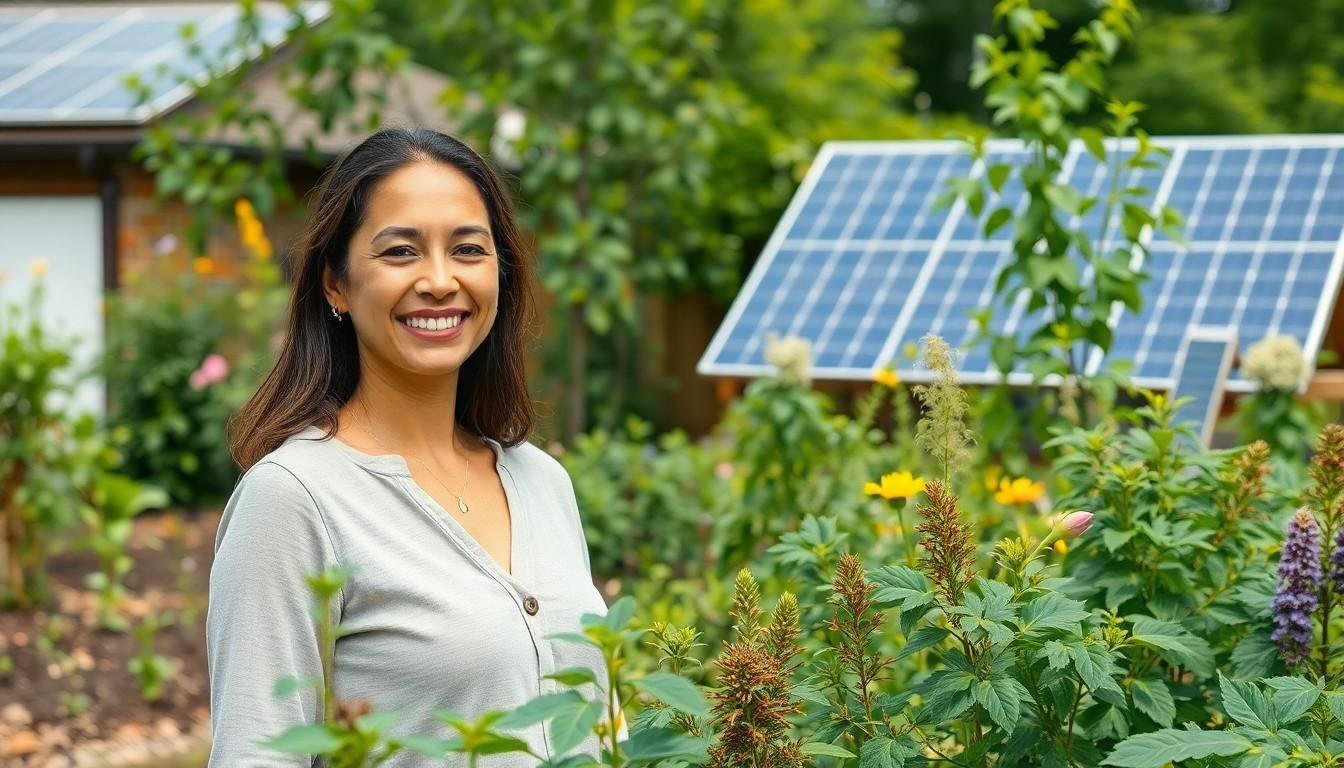In a world where plastic seems to grow on trees and fast fashion is the new black, sustainable living might sound like a distant dream. But fear not! It’s not just for eco-warriors with beards and hemp sandals anymore. Everyday folks are discovering that living sustainably can be as easy as swapping out their morning coffee cup for a reusable one, or even growing a herb garden on their windowsill.
Sustainable living examples are popping up everywhere, and they’re not only good for the planet but can also save some serious cash. Imagine reducing your utility bills while saving the Earth—now that’s what we call a win-win! So buckle up and get ready to explore practical, fun, and sometimes downright quirky ways to embrace sustainability in daily life. Who knew saving the planet could be this entertaining?
sustainable living examples
Sustainable living encompasses practices that reduce an individual’s or community’s environmental impact. This lifestyle choice integrates eco-friendly habits into daily routines, making it approachable for everyone. People make conscious decisions in areas like consumption, waste, and energy use.
Reusables play a crucial role in this approach. Choosing reusable bags, containers, and water bottles minimizes single-use plastics. It’s estimated that a single reusable bag replaces 600 plastic bags over its lifetime, demonstrating the significant difference one can make.
Incorporating energy-efficient appliances presents another example. These devices consume less power, reducing monthly utility bills while decreasing carbon footprints. For instance, replacing incandescent bulbs with LED lights can cut energy use by up to 80%, providing both environmental and economic benefits.
Urban gardening offers a hands-on way to embrace sustainability. Growing herbs, vegetables, or fruits at home leads to fresher produce and less reliance on store-bought options. Statistics show that home gardens can reduce household food waste by up to 40%, making efforts worthwhile.
Participating in local community initiatives strengthens connections while promoting sustainability. Volunteering for beach clean-ups or tree-planting events enhances community ties while contributing positively to the environment. Engaging in these activities fosters a sense of purpose and shared responsibility.
Transitioning to sustainable living also includes mindful consumption. Opting for locally sourced products minimizes transportation emissions and supports local economies. Research indicates that buying local can cut associated carbon emissions by up to 20%, reinforcing this beneficial choice.
By adopting small, manageable changes, anyone can contribute to a more sustainable future. Emphasizing practicality, sustainable living promotes an engaging, beneficial lifestyle that profits both individuals and the planet.
Examples of Sustainable Living

Numerous practical examples illustrate sustainable living. These examples show simple methods to integrate eco-friendly practices into daily routines.
Renewable Energy Sources
Solar panels provide an efficient way to harness sunlight for electricity. Wind turbines convert wind energy into usable power for homes and businesses. Geothermal systems utilize heat from the earth for heating and cooling. Each of these renewable energy sources reduces reliance on fossil fuels, which helps lower carbon emissions. Investing in these technologies can lead to significant energy savings over time. Households adopting solar energy can see a reduction of up to 30% on their electric bills, showcasing the financial and environmental benefits.
Water Conservation Practices
Water-saving fixtures benefit both the environment and household budgets. Low-flow showerheads and faucets can reduce water usage by 30% or more. Rainwater harvesting systems collect rainfall for irrigation and other non-potable uses. Native landscaping requires less water and supports local wildlife. Simple habits like turning off the tap while brushing teeth or fixing leaks can conserve significant amounts of water daily. The cumulative effect contributes to more sustainable water management, benefiting both communities and ecosystems.
Sustainable Transportation Methods
Sustainable transportation methods play a crucial role in reducing carbon footprints. These alternatives enhance accessibility while promoting eco-friendly habits within communities.
Public Transit Options
Public transportation systems cut down on individual vehicle usage. They offer efficient and cost-effective means for commuting in urban areas. Buses, subways, and trains pack multiple passengers, significantly slashing greenhouse gas emissions. Cities investing in electrified transit systems demonstrate commitment to sustainability. Furthermore, integrating bike lanes with public transport encourages mixed-use travel options, making it easier to transition from one mode to another.
Biking and Walking Initiatives
Biking and walking initiatives promote a healthier lifestyle and reduce reliance on fossil fuels. Cities adopting bike-sharing programs boost local health and sustainability. Safe walking paths and bike lanes encourage more people to choose these modes of transport. Benefits extend to lower traffic congestion and improved air quality as cycling and walking create zero emissions. Communities can also host events, such as car-free days, that highlight and celebrate the advantages of active transportation.
Sustainable Agriculture Practices
Sustainable agriculture practices significantly contribute to eco-friendly living by prioritizing environmental health and community well-being. These methods often emphasize the production of food that is beneficial for both consumers and the ecosystem.
Organic Farming
Organic farming utilizes natural processes to cultivate crops without synthetic chemicals. Farmers leverage crop rotation and composting, rather than reliance on pesticides, to ensure soil fertility and promote biodiversity. They often practice companion planting, which enhances pest control naturally. This approach improves soil health, fosters resilience against pests, and provides healthier produce for consumers. According to the USDA, organic farming demonstrates a commitment to sustainable practices, promoting environmental integrity.
Community Supported Agriculture (CSA)
Community Supported Agriculture (CSA) connects local farmers directly with consumers. Participants buy shares of a farm’s harvest upfront, which supports farmers financially and creates a direct relationship between them and their communities. Weekly deliveries or pickups offer fresh, seasonal produce, reducing transportation emissions. CSAs encourage the consumption of local food, which helps strengthen local economies and minimizes food waste. By investing in a CSA, individuals support sustainable farming practices and enhance food security within their communities.
Sustainable Home Design
Sustainable home design focuses on creating living spaces that minimize environmental impact while maximizing comfort and efficiency. These designs integrate eco-friendly principles that are accessible to everyone.
Eco-Friendly Materials
Choosing eco-friendly materials contributes significantly to sustainable home design. Bamboo, reclaimed wood, and recycled metal serve as sustainable options that reduce resource consumption. Insulation made from recycled products enhances energy conservation, aiding in temperature regulation. Low-VOC paints and finishes improve indoor air quality, creating a healthier living environment. Furthermore, using natural stone, such as slate or granite, provides durability and aesthetics without sacrificing environmental responsibility.
Energy-Efficient Appliances
Energy-efficient appliances play a critical role in sustainable living. Appliances bearing the ENERGY STAR label consume less energy while providing the same performance as traditional models. Selecting Energy Star-rated refrigerators, dishwashers, and washing machines reduces household energy bills and lowers carbon footprints. Integrating smart thermostats allows for optimized energy usage, adjusting heating and cooling based on occupancy patterns. Utilizing LED lighting throughout the home not only extends bulb life but also significantly reduces electricity consumption. These choices contribute to both sustainability and cost savings over time.
healthier planet for future generations
Embracing sustainable living is a journey that anyone can embark on. By incorporating simple practices into daily routines individuals can make a significant impact on the environment while enjoying financial benefits. Every small action counts from using reusable items to supporting local agriculture.
As communities come together to promote eco-friendly habits the collective effort strengthens connections and fosters a culture of sustainability. With continued awareness and commitment to sustainable choices people can contribute to a healthier planet for future generations. This lifestyle not only enhances personal well-being but also nurtures the earth we all share.

